Clinical Reasoning Cycle Application: Respiratory Distress Case Study
VerifiedAdded on 2023/06/07
|10
|2635
|261
Case Study
AI Summary
This case study explores the application of the clinical reasoning cycle in managing a 79-year-old patient, Mrs. Connie Brownstone, admitted with respiratory distress due to asthma exacerbation. The analysis covers each stage of the cycle, including collecting care cues from patient history and triage data, processing information to identify acute respiratory alkalosis and hypoxia, prioritizing care needs such as dyspnea and acid-base imbalance, establishing measurable care goals, and implementing interventions like bronchodilators, oxygen therapy, and anti-arrhythmic medication. The evaluation of outcomes demonstrates improved patient condition within 24 hours, and the reflection emphasizes the importance of the clinical reasoning cycle in guiding effective patient-centered care. The study concludes that the clinical reasoning cycle is essential for nurses to provide individualized care for patients with complex needs.
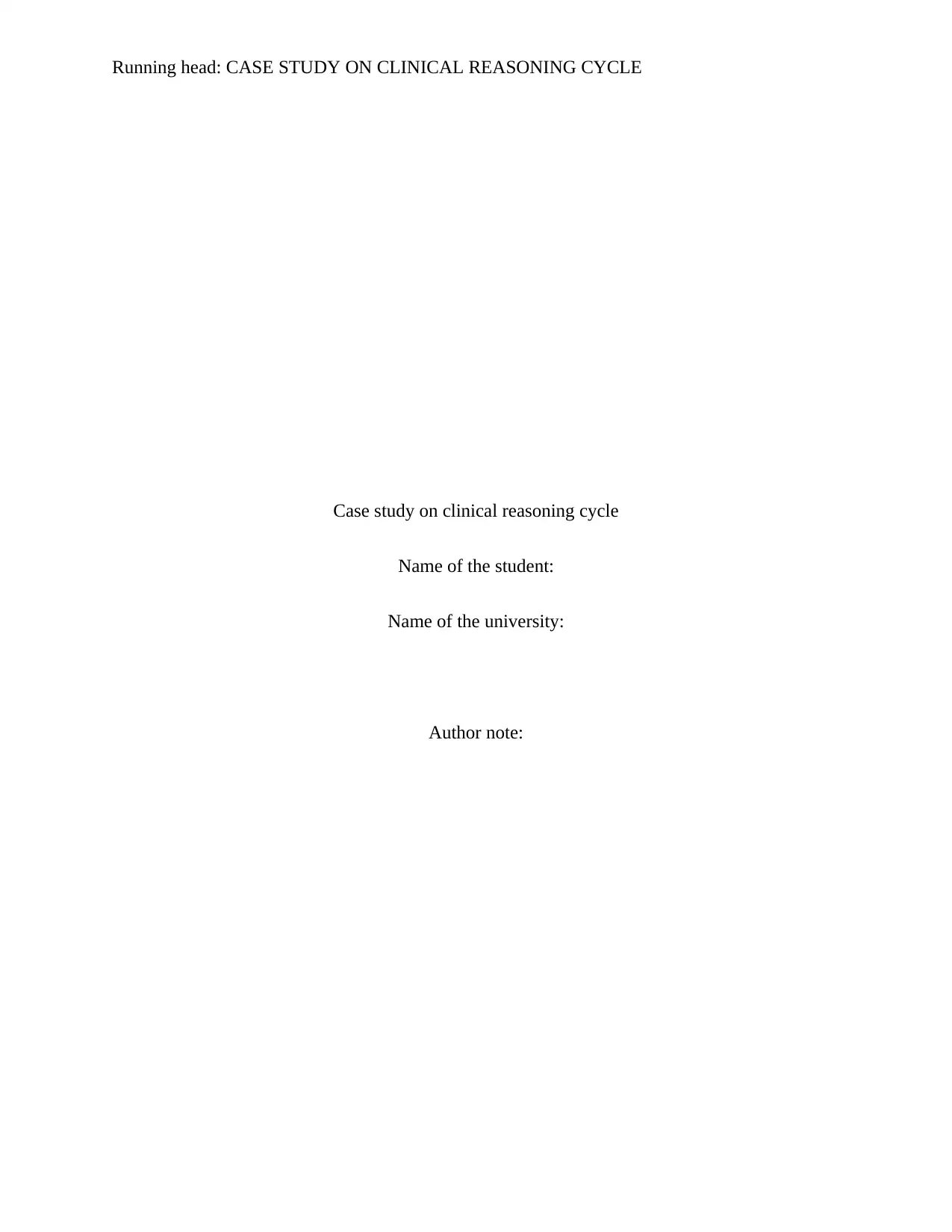
Running head: CASE STUDY ON CLINICAL REASONING CYCLE
Case study on clinical reasoning cycle
Name of the student:
Name of the university:
Author note:
Case study on clinical reasoning cycle
Name of the student:
Name of the university:
Author note:
Paraphrase This Document
Need a fresh take? Get an instant paraphrase of this document with our AI Paraphraser
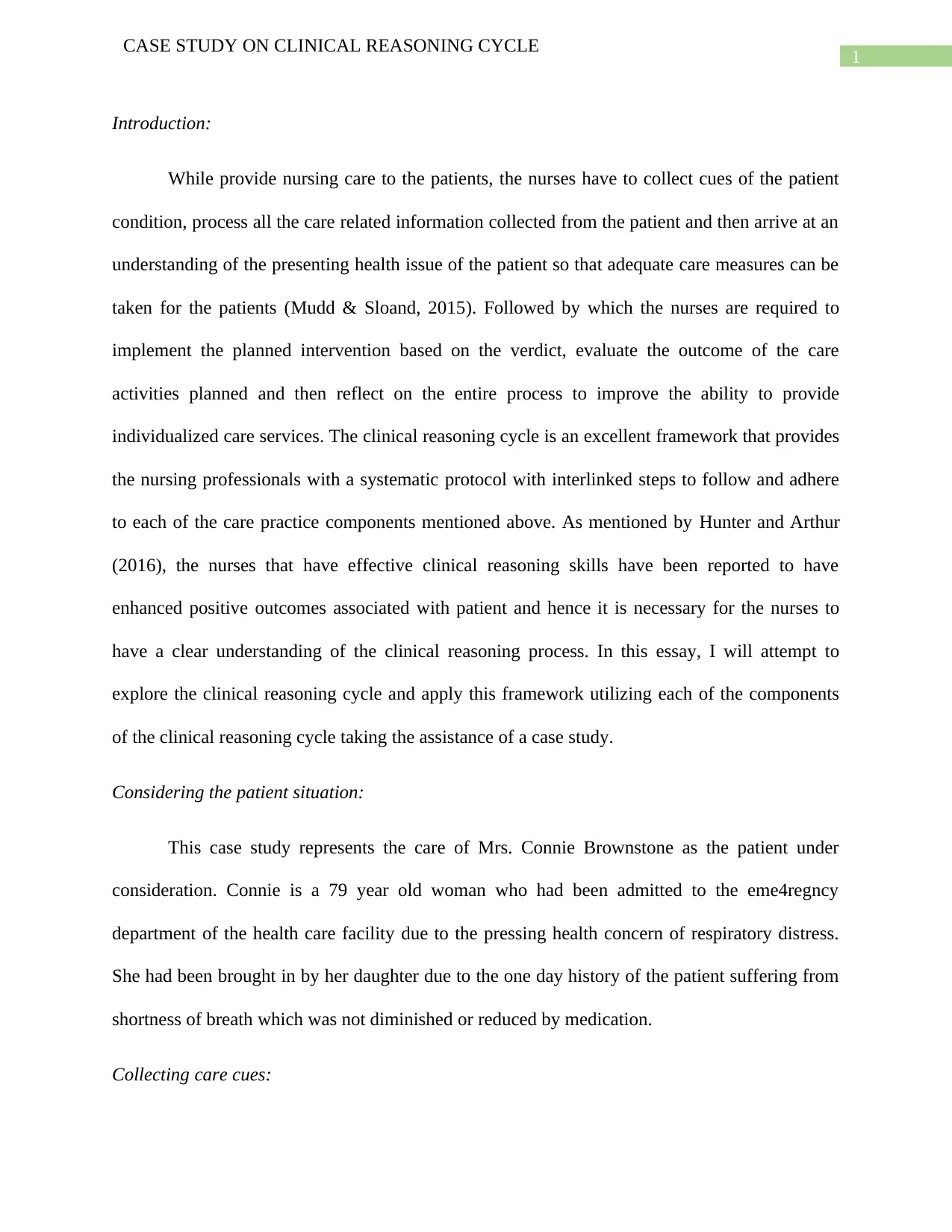
1
CASE STUDY ON CLINICAL REASONING CYCLE
Introduction:
While provide nursing care to the patients, the nurses have to collect cues of the patient
condition, process all the care related information collected from the patient and then arrive at an
understanding of the presenting health issue of the patient so that adequate care measures can be
taken for the patients (Mudd & Sloand, 2015). Followed by which the nurses are required to
implement the planned intervention based on the verdict, evaluate the outcome of the care
activities planned and then reflect on the entire process to improve the ability to provide
individualized care services. The clinical reasoning cycle is an excellent framework that provides
the nursing professionals with a systematic protocol with interlinked steps to follow and adhere
to each of the care practice components mentioned above. As mentioned by Hunter and Arthur
(2016), the nurses that have effective clinical reasoning skills have been reported to have
enhanced positive outcomes associated with patient and hence it is necessary for the nurses to
have a clear understanding of the clinical reasoning process. In this essay, I will attempt to
explore the clinical reasoning cycle and apply this framework utilizing each of the components
of the clinical reasoning cycle taking the assistance of a case study.
Considering the patient situation:
This case study represents the care of Mrs. Connie Brownstone as the patient under
consideration. Connie is a 79 year old woman who had been admitted to the eme4regncy
department of the health care facility due to the pressing health concern of respiratory distress.
She had been brought in by her daughter due to the one day history of the patient suffering from
shortness of breath which was not diminished or reduced by medication.
Collecting care cues:
CASE STUDY ON CLINICAL REASONING CYCLE
Introduction:
While provide nursing care to the patients, the nurses have to collect cues of the patient
condition, process all the care related information collected from the patient and then arrive at an
understanding of the presenting health issue of the patient so that adequate care measures can be
taken for the patients (Mudd & Sloand, 2015). Followed by which the nurses are required to
implement the planned intervention based on the verdict, evaluate the outcome of the care
activities planned and then reflect on the entire process to improve the ability to provide
individualized care services. The clinical reasoning cycle is an excellent framework that provides
the nursing professionals with a systematic protocol with interlinked steps to follow and adhere
to each of the care practice components mentioned above. As mentioned by Hunter and Arthur
(2016), the nurses that have effective clinical reasoning skills have been reported to have
enhanced positive outcomes associated with patient and hence it is necessary for the nurses to
have a clear understanding of the clinical reasoning process. In this essay, I will attempt to
explore the clinical reasoning cycle and apply this framework utilizing each of the components
of the clinical reasoning cycle taking the assistance of a case study.
Considering the patient situation:
This case study represents the care of Mrs. Connie Brownstone as the patient under
consideration. Connie is a 79 year old woman who had been admitted to the eme4regncy
department of the health care facility due to the pressing health concern of respiratory distress.
She had been brought in by her daughter due to the one day history of the patient suffering from
shortness of breath which was not diminished or reduced by medication.
Collecting care cues:
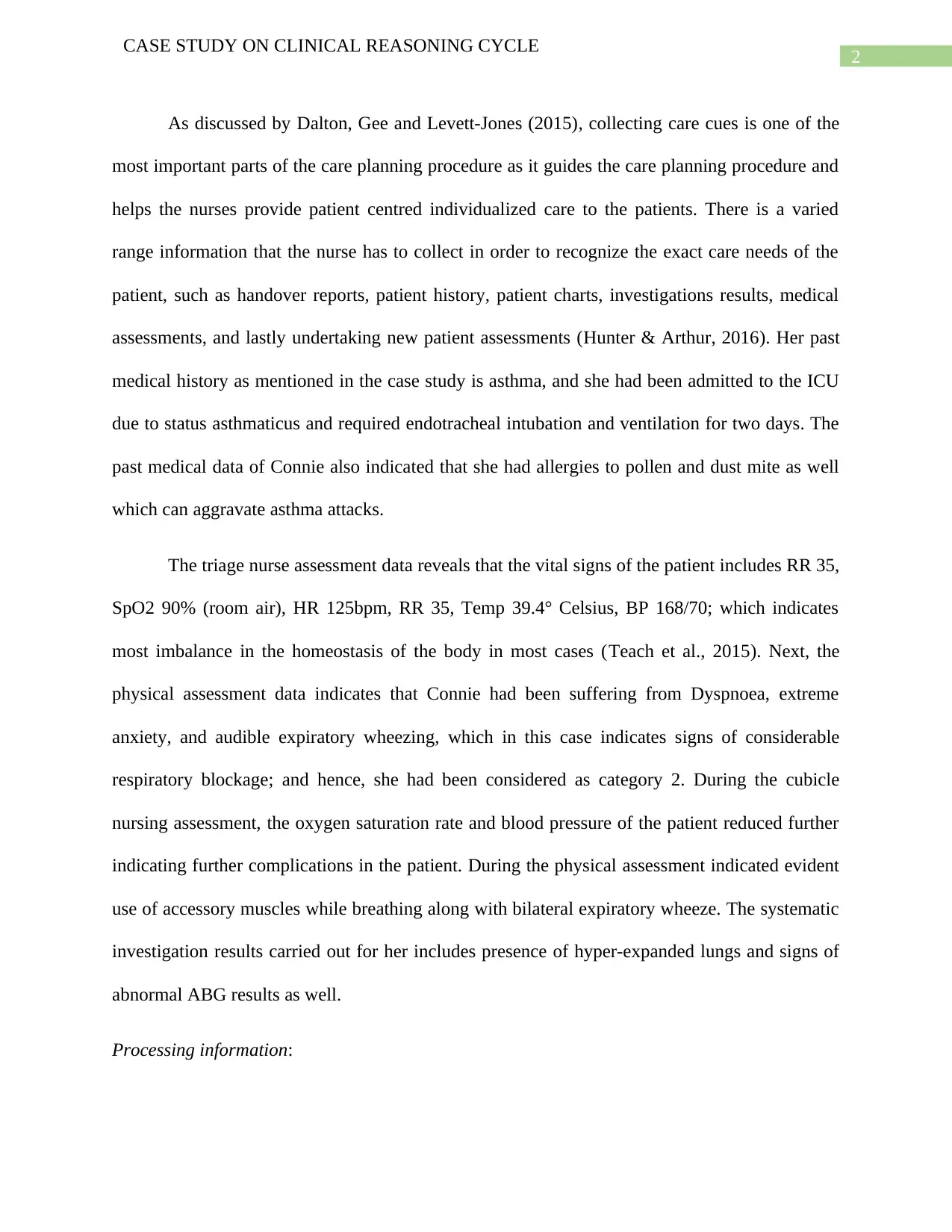
2
CASE STUDY ON CLINICAL REASONING CYCLE
As discussed by Dalton, Gee and Levett-Jones (2015), collecting care cues is one of the
most important parts of the care planning procedure as it guides the care planning procedure and
helps the nurses provide patient centred individualized care to the patients. There is a varied
range information that the nurse has to collect in order to recognize the exact care needs of the
patient, such as handover reports, patient history, patient charts, investigations results, medical
assessments, and lastly undertaking new patient assessments (Hunter & Arthur, 2016). Her past
medical history as mentioned in the case study is asthma, and she had been admitted to the ICU
due to status asthmaticus and required endotracheal intubation and ventilation for two days. The
past medical data of Connie also indicated that she had allergies to pollen and dust mite as well
which can aggravate asthma attacks.
The triage nurse assessment data reveals that the vital signs of the patient includes RR 35,
SpO2 90% (room air), HR 125bpm, RR 35, Temp 39.4° Celsius, BP 168/70; which indicates
most imbalance in the homeostasis of the body in most cases (Teach et al., 2015). Next, the
physical assessment data indicates that Connie had been suffering from Dyspnoea, extreme
anxiety, and audible expiratory wheezing, which in this case indicates signs of considerable
respiratory blockage; and hence, she had been considered as category 2. During the cubicle
nursing assessment, the oxygen saturation rate and blood pressure of the patient reduced further
indicating further complications in the patient. During the physical assessment indicated evident
use of accessory muscles while breathing along with bilateral expiratory wheeze. The systematic
investigation results carried out for her includes presence of hyper-expanded lungs and signs of
abnormal ABG results as well.
Processing information:
CASE STUDY ON CLINICAL REASONING CYCLE
As discussed by Dalton, Gee and Levett-Jones (2015), collecting care cues is one of the
most important parts of the care planning procedure as it guides the care planning procedure and
helps the nurses provide patient centred individualized care to the patients. There is a varied
range information that the nurse has to collect in order to recognize the exact care needs of the
patient, such as handover reports, patient history, patient charts, investigations results, medical
assessments, and lastly undertaking new patient assessments (Hunter & Arthur, 2016). Her past
medical history as mentioned in the case study is asthma, and she had been admitted to the ICU
due to status asthmaticus and required endotracheal intubation and ventilation for two days. The
past medical data of Connie also indicated that she had allergies to pollen and dust mite as well
which can aggravate asthma attacks.
The triage nurse assessment data reveals that the vital signs of the patient includes RR 35,
SpO2 90% (room air), HR 125bpm, RR 35, Temp 39.4° Celsius, BP 168/70; which indicates
most imbalance in the homeostasis of the body in most cases (Teach et al., 2015). Next, the
physical assessment data indicates that Connie had been suffering from Dyspnoea, extreme
anxiety, and audible expiratory wheezing, which in this case indicates signs of considerable
respiratory blockage; and hence, she had been considered as category 2. During the cubicle
nursing assessment, the oxygen saturation rate and blood pressure of the patient reduced further
indicating further complications in the patient. During the physical assessment indicated evident
use of accessory muscles while breathing along with bilateral expiratory wheeze. The systematic
investigation results carried out for her includes presence of hyper-expanded lungs and signs of
abnormal ABG results as well.
Processing information:
⊘ This is a preview!⊘
Do you want full access?
Subscribe today to unlock all pages.

Trusted by 1+ million students worldwide
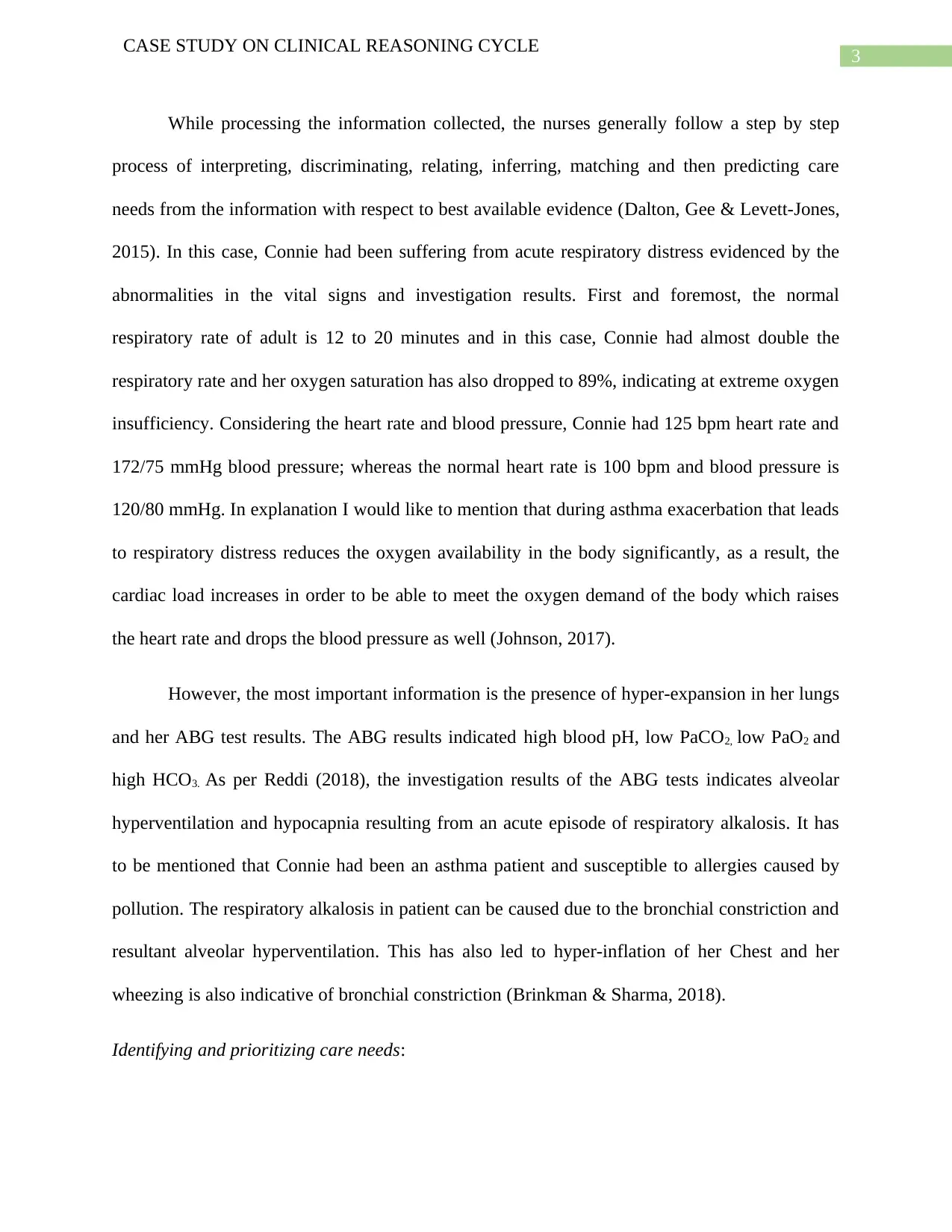
3
CASE STUDY ON CLINICAL REASONING CYCLE
While processing the information collected, the nurses generally follow a step by step
process of interpreting, discriminating, relating, inferring, matching and then predicting care
needs from the information with respect to best available evidence (Dalton, Gee & Levett-Jones,
2015). In this case, Connie had been suffering from acute respiratory distress evidenced by the
abnormalities in the vital signs and investigation results. First and foremost, the normal
respiratory rate of adult is 12 to 20 minutes and in this case, Connie had almost double the
respiratory rate and her oxygen saturation has also dropped to 89%, indicating at extreme oxygen
insufficiency. Considering the heart rate and blood pressure, Connie had 125 bpm heart rate and
172/75 mmHg blood pressure; whereas the normal heart rate is 100 bpm and blood pressure is
120/80 mmHg. In explanation I would like to mention that during asthma exacerbation that leads
to respiratory distress reduces the oxygen availability in the body significantly, as a result, the
cardiac load increases in order to be able to meet the oxygen demand of the body which raises
the heart rate and drops the blood pressure as well (Johnson, 2017).
However, the most important information is the presence of hyper-expansion in her lungs
and her ABG test results. The ABG results indicated high blood pH, low PaCO2, low PaO2 and
high HCO3. As per Reddi (2018), the investigation results of the ABG tests indicates alveolar
hyperventilation and hypocapnia resulting from an acute episode of respiratory alkalosis. It has
to be mentioned that Connie had been an asthma patient and susceptible to allergies caused by
pollution. The respiratory alkalosis in patient can be caused due to the bronchial constriction and
resultant alveolar hyperventilation. This has also led to hyper-inflation of her Chest and her
wheezing is also indicative of bronchial constriction (Brinkman & Sharma, 2018).
Identifying and prioritizing care needs:
CASE STUDY ON CLINICAL REASONING CYCLE
While processing the information collected, the nurses generally follow a step by step
process of interpreting, discriminating, relating, inferring, matching and then predicting care
needs from the information with respect to best available evidence (Dalton, Gee & Levett-Jones,
2015). In this case, Connie had been suffering from acute respiratory distress evidenced by the
abnormalities in the vital signs and investigation results. First and foremost, the normal
respiratory rate of adult is 12 to 20 minutes and in this case, Connie had almost double the
respiratory rate and her oxygen saturation has also dropped to 89%, indicating at extreme oxygen
insufficiency. Considering the heart rate and blood pressure, Connie had 125 bpm heart rate and
172/75 mmHg blood pressure; whereas the normal heart rate is 100 bpm and blood pressure is
120/80 mmHg. In explanation I would like to mention that during asthma exacerbation that leads
to respiratory distress reduces the oxygen availability in the body significantly, as a result, the
cardiac load increases in order to be able to meet the oxygen demand of the body which raises
the heart rate and drops the blood pressure as well (Johnson, 2017).
However, the most important information is the presence of hyper-expansion in her lungs
and her ABG test results. The ABG results indicated high blood pH, low PaCO2, low PaO2 and
high HCO3. As per Reddi (2018), the investigation results of the ABG tests indicates alveolar
hyperventilation and hypocapnia resulting from an acute episode of respiratory alkalosis. It has
to be mentioned that Connie had been an asthma patient and susceptible to allergies caused by
pollution. The respiratory alkalosis in patient can be caused due to the bronchial constriction and
resultant alveolar hyperventilation. This has also led to hyper-inflation of her Chest and her
wheezing is also indicative of bronchial constriction (Brinkman & Sharma, 2018).
Identifying and prioritizing care needs:
Paraphrase This Document
Need a fresh take? Get an instant paraphrase of this document with our AI Paraphraser
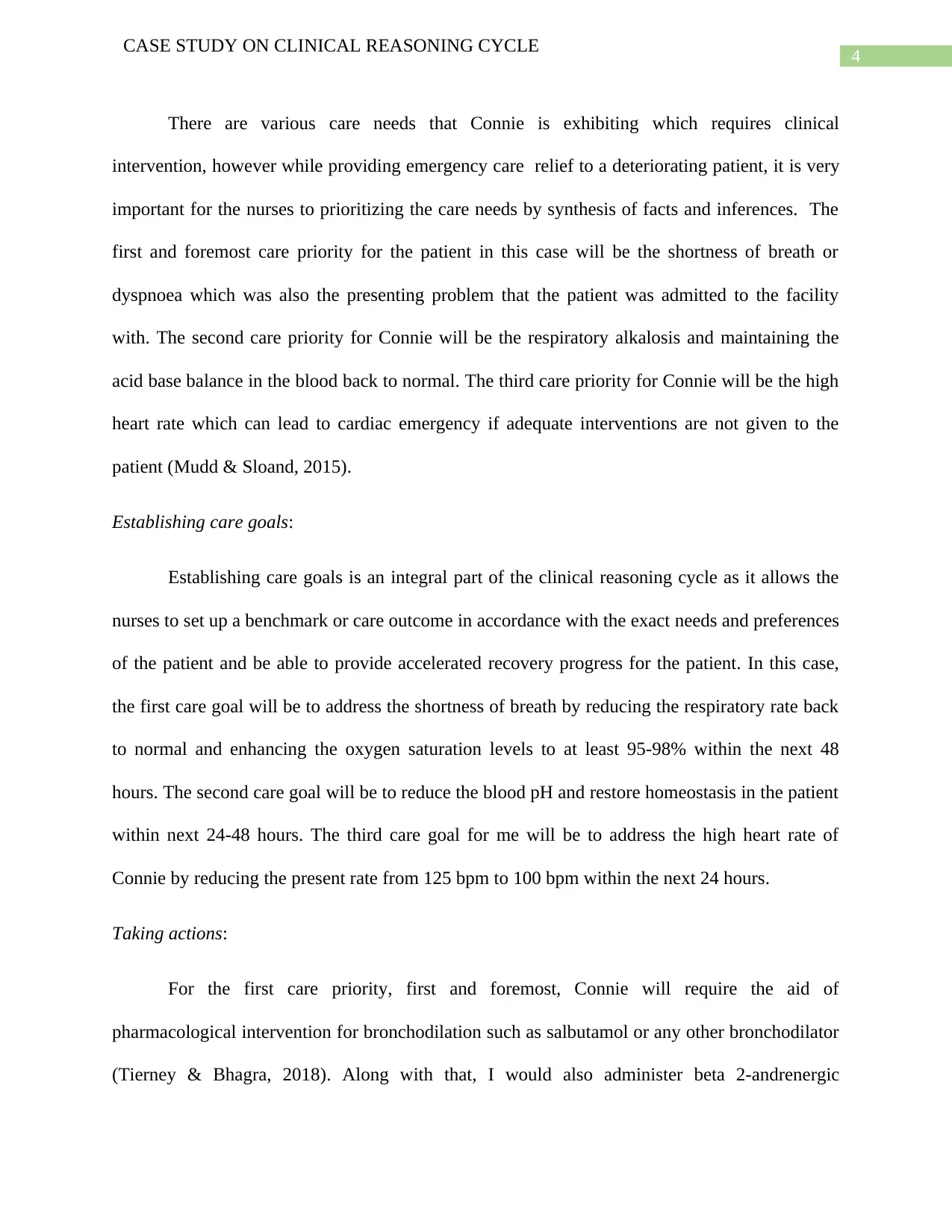
4
CASE STUDY ON CLINICAL REASONING CYCLE
There are various care needs that Connie is exhibiting which requires clinical
intervention, however while providing emergency care relief to a deteriorating patient, it is very
important for the nurses to prioritizing the care needs by synthesis of facts and inferences. The
first and foremost care priority for the patient in this case will be the shortness of breath or
dyspnoea which was also the presenting problem that the patient was admitted to the facility
with. The second care priority for Connie will be the respiratory alkalosis and maintaining the
acid base balance in the blood back to normal. The third care priority for Connie will be the high
heart rate which can lead to cardiac emergency if adequate interventions are not given to the
patient (Mudd & Sloand, 2015).
Establishing care goals:
Establishing care goals is an integral part of the clinical reasoning cycle as it allows the
nurses to set up a benchmark or care outcome in accordance with the exact needs and preferences
of the patient and be able to provide accelerated recovery progress for the patient. In this case,
the first care goal will be to address the shortness of breath by reducing the respiratory rate back
to normal and enhancing the oxygen saturation levels to at least 95-98% within the next 48
hours. The second care goal will be to reduce the blood pH and restore homeostasis in the patient
within next 24-48 hours. The third care goal for me will be to address the high heart rate of
Connie by reducing the present rate from 125 bpm to 100 bpm within the next 24 hours.
Taking actions:
For the first care priority, first and foremost, Connie will require the aid of
pharmacological intervention for bronchodilation such as salbutamol or any other bronchodilator
(Tierney & Bhagra, 2018). Along with that, I would also administer beta 2-andrenergic
CASE STUDY ON CLINICAL REASONING CYCLE
There are various care needs that Connie is exhibiting which requires clinical
intervention, however while providing emergency care relief to a deteriorating patient, it is very
important for the nurses to prioritizing the care needs by synthesis of facts and inferences. The
first and foremost care priority for the patient in this case will be the shortness of breath or
dyspnoea which was also the presenting problem that the patient was admitted to the facility
with. The second care priority for Connie will be the respiratory alkalosis and maintaining the
acid base balance in the blood back to normal. The third care priority for Connie will be the high
heart rate which can lead to cardiac emergency if adequate interventions are not given to the
patient (Mudd & Sloand, 2015).
Establishing care goals:
Establishing care goals is an integral part of the clinical reasoning cycle as it allows the
nurses to set up a benchmark or care outcome in accordance with the exact needs and preferences
of the patient and be able to provide accelerated recovery progress for the patient. In this case,
the first care goal will be to address the shortness of breath by reducing the respiratory rate back
to normal and enhancing the oxygen saturation levels to at least 95-98% within the next 48
hours. The second care goal will be to reduce the blood pH and restore homeostasis in the patient
within next 24-48 hours. The third care goal for me will be to address the high heart rate of
Connie by reducing the present rate from 125 bpm to 100 bpm within the next 24 hours.
Taking actions:
For the first care priority, first and foremost, Connie will require the aid of
pharmacological intervention for bronchodilation such as salbutamol or any other bronchodilator
(Tierney & Bhagra, 2018). Along with that, I would also administer beta 2-andrenergic
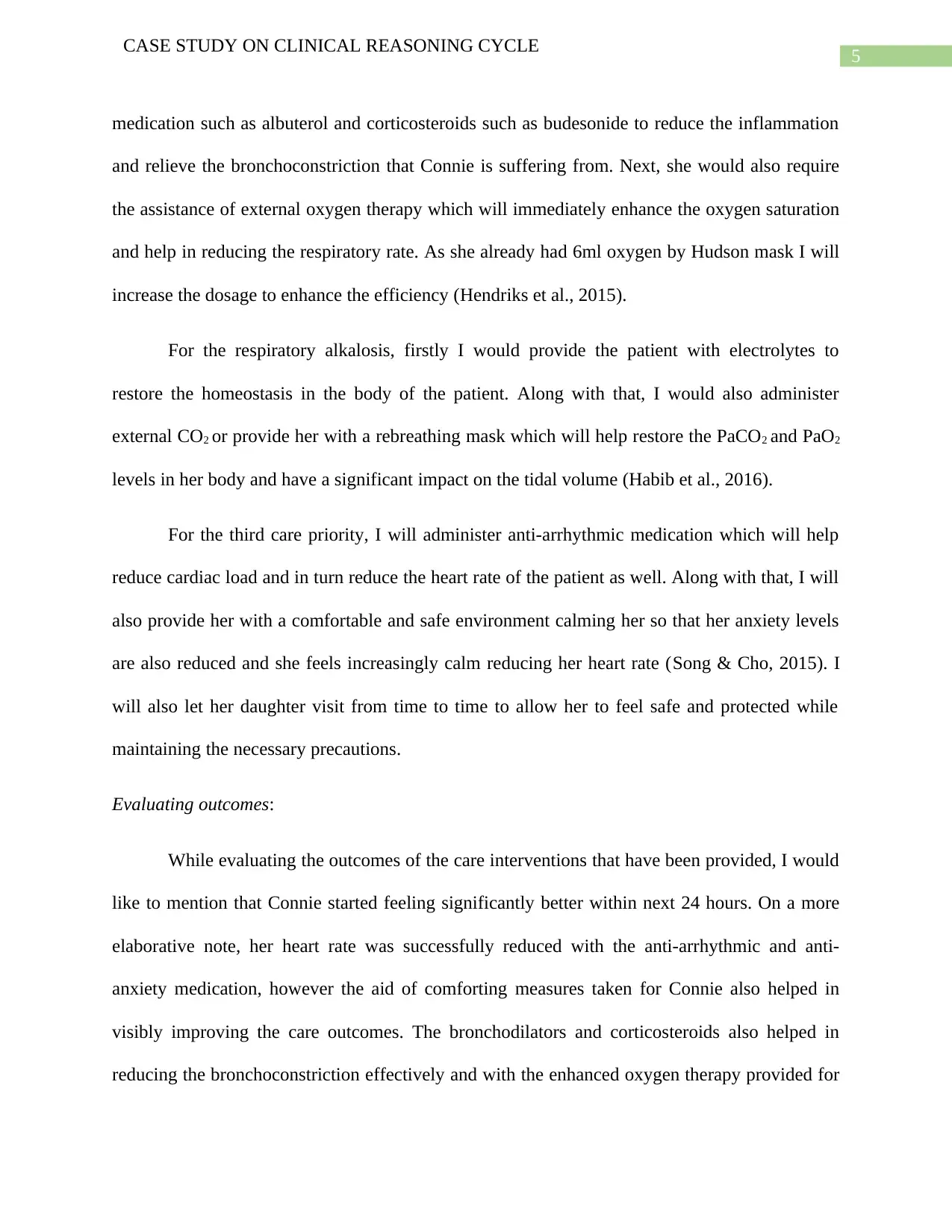
5
CASE STUDY ON CLINICAL REASONING CYCLE
medication such as albuterol and corticosteroids such as budesonide to reduce the inflammation
and relieve the bronchoconstriction that Connie is suffering from. Next, she would also require
the assistance of external oxygen therapy which will immediately enhance the oxygen saturation
and help in reducing the respiratory rate. As she already had 6ml oxygen by Hudson mask I will
increase the dosage to enhance the efficiency (Hendriks et al., 2015).
For the respiratory alkalosis, firstly I would provide the patient with electrolytes to
restore the homeostasis in the body of the patient. Along with that, I would also administer
external CO2 or provide her with a rebreathing mask which will help restore the PaCO2 and PaO2
levels in her body and have a significant impact on the tidal volume (Habib et al., 2016).
For the third care priority, I will administer anti-arrhythmic medication which will help
reduce cardiac load and in turn reduce the heart rate of the patient as well. Along with that, I will
also provide her with a comfortable and safe environment calming her so that her anxiety levels
are also reduced and she feels increasingly calm reducing her heart rate (Song & Cho, 2015). I
will also let her daughter visit from time to time to allow her to feel safe and protected while
maintaining the necessary precautions.
Evaluating outcomes:
While evaluating the outcomes of the care interventions that have been provided, I would
like to mention that Connie started feeling significantly better within next 24 hours. On a more
elaborative note, her heart rate was successfully reduced with the anti-arrhythmic and anti-
anxiety medication, however the aid of comforting measures taken for Connie also helped in
visibly improving the care outcomes. The bronchodilators and corticosteroids also helped in
reducing the bronchoconstriction effectively and with the enhanced oxygen therapy provided for
CASE STUDY ON CLINICAL REASONING CYCLE
medication such as albuterol and corticosteroids such as budesonide to reduce the inflammation
and relieve the bronchoconstriction that Connie is suffering from. Next, she would also require
the assistance of external oxygen therapy which will immediately enhance the oxygen saturation
and help in reducing the respiratory rate. As she already had 6ml oxygen by Hudson mask I will
increase the dosage to enhance the efficiency (Hendriks et al., 2015).
For the respiratory alkalosis, firstly I would provide the patient with electrolytes to
restore the homeostasis in the body of the patient. Along with that, I would also administer
external CO2 or provide her with a rebreathing mask which will help restore the PaCO2 and PaO2
levels in her body and have a significant impact on the tidal volume (Habib et al., 2016).
For the third care priority, I will administer anti-arrhythmic medication which will help
reduce cardiac load and in turn reduce the heart rate of the patient as well. Along with that, I will
also provide her with a comfortable and safe environment calming her so that her anxiety levels
are also reduced and she feels increasingly calm reducing her heart rate (Song & Cho, 2015). I
will also let her daughter visit from time to time to allow her to feel safe and protected while
maintaining the necessary precautions.
Evaluating outcomes:
While evaluating the outcomes of the care interventions that have been provided, I would
like to mention that Connie started feeling significantly better within next 24 hours. On a more
elaborative note, her heart rate was successfully reduced with the anti-arrhythmic and anti-
anxiety medication, however the aid of comforting measures taken for Connie also helped in
visibly improving the care outcomes. The bronchodilators and corticosteroids also helped in
reducing the bronchoconstriction effectively and with the enhanced oxygen therapy provided for
⊘ This is a preview!⊘
Do you want full access?
Subscribe today to unlock all pages.

Trusted by 1+ million students worldwide
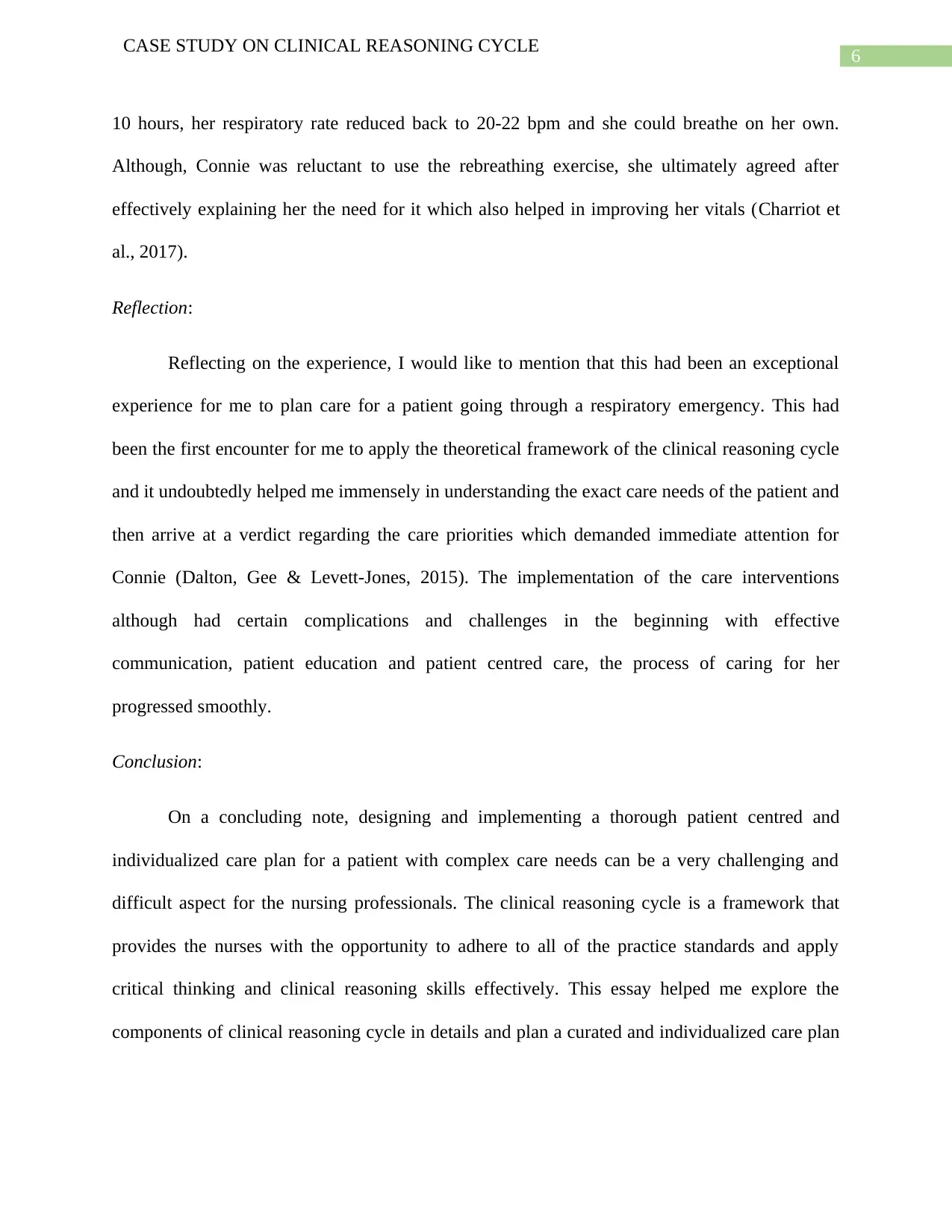
6
CASE STUDY ON CLINICAL REASONING CYCLE
10 hours, her respiratory rate reduced back to 20-22 bpm and she could breathe on her own.
Although, Connie was reluctant to use the rebreathing exercise, she ultimately agreed after
effectively explaining her the need for it which also helped in improving her vitals (Charriot et
al., 2017).
Reflection:
Reflecting on the experience, I would like to mention that this had been an exceptional
experience for me to plan care for a patient going through a respiratory emergency. This had
been the first encounter for me to apply the theoretical framework of the clinical reasoning cycle
and it undoubtedly helped me immensely in understanding the exact care needs of the patient and
then arrive at a verdict regarding the care priorities which demanded immediate attention for
Connie (Dalton, Gee & Levett-Jones, 2015). The implementation of the care interventions
although had certain complications and challenges in the beginning with effective
communication, patient education and patient centred care, the process of caring for her
progressed smoothly.
Conclusion:
On a concluding note, designing and implementing a thorough patient centred and
individualized care plan for a patient with complex care needs can be a very challenging and
difficult aspect for the nursing professionals. The clinical reasoning cycle is a framework that
provides the nurses with the opportunity to adhere to all of the practice standards and apply
critical thinking and clinical reasoning skills effectively. This essay helped me explore the
components of clinical reasoning cycle in details and plan a curated and individualized care plan
CASE STUDY ON CLINICAL REASONING CYCLE
10 hours, her respiratory rate reduced back to 20-22 bpm and she could breathe on her own.
Although, Connie was reluctant to use the rebreathing exercise, she ultimately agreed after
effectively explaining her the need for it which also helped in improving her vitals (Charriot et
al., 2017).
Reflection:
Reflecting on the experience, I would like to mention that this had been an exceptional
experience for me to plan care for a patient going through a respiratory emergency. This had
been the first encounter for me to apply the theoretical framework of the clinical reasoning cycle
and it undoubtedly helped me immensely in understanding the exact care needs of the patient and
then arrive at a verdict regarding the care priorities which demanded immediate attention for
Connie (Dalton, Gee & Levett-Jones, 2015). The implementation of the care interventions
although had certain complications and challenges in the beginning with effective
communication, patient education and patient centred care, the process of caring for her
progressed smoothly.
Conclusion:
On a concluding note, designing and implementing a thorough patient centred and
individualized care plan for a patient with complex care needs can be a very challenging and
difficult aspect for the nursing professionals. The clinical reasoning cycle is a framework that
provides the nurses with the opportunity to adhere to all of the practice standards and apply
critical thinking and clinical reasoning skills effectively. This essay helped me explore the
components of clinical reasoning cycle in details and plan a curated and individualized care plan
Paraphrase This Document
Need a fresh take? Get an instant paraphrase of this document with our AI Paraphraser

7
CASE STUDY ON CLINICAL REASONING CYCLE
for a patient with complex care needs and I believe that this experience will guide my future
practice excellently.
CASE STUDY ON CLINICAL REASONING CYCLE
for a patient with complex care needs and I believe that this experience will guide my future
practice excellently.
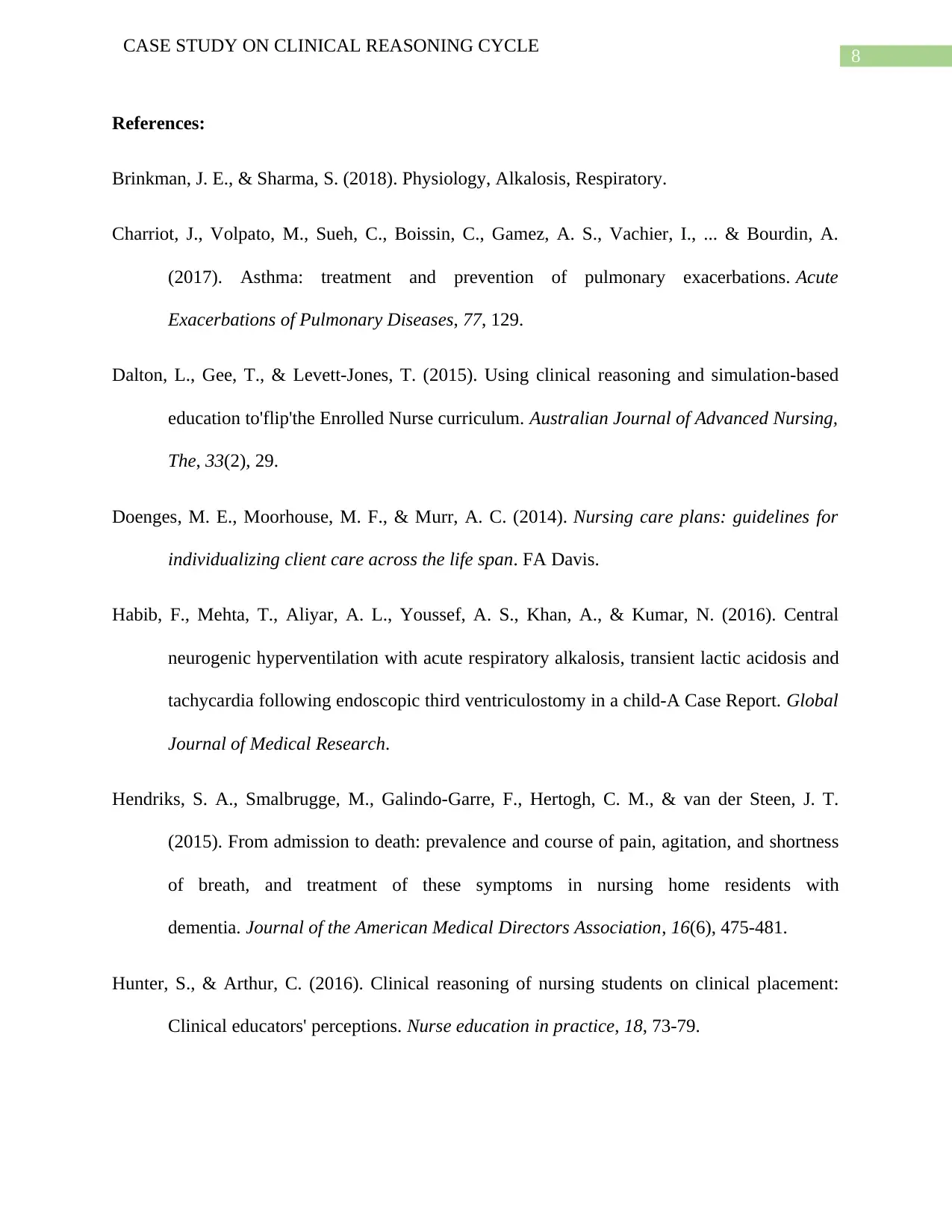
8
CASE STUDY ON CLINICAL REASONING CYCLE
References:
Brinkman, J. E., & Sharma, S. (2018). Physiology, Alkalosis, Respiratory.
Charriot, J., Volpato, M., Sueh, C., Boissin, C., Gamez, A. S., Vachier, I., ... & Bourdin, A.
(2017). Asthma: treatment and prevention of pulmonary exacerbations. Acute
Exacerbations of Pulmonary Diseases, 77, 129.
Dalton, L., Gee, T., & Levett-Jones, T. (2015). Using clinical reasoning and simulation-based
education to'flip'the Enrolled Nurse curriculum. Australian Journal of Advanced Nursing,
The, 33(2), 29.
Doenges, M. E., Moorhouse, M. F., & Murr, A. C. (2014). Nursing care plans: guidelines for
individualizing client care across the life span. FA Davis.
Habib, F., Mehta, T., Aliyar, A. L., Youssef, A. S., Khan, A., & Kumar, N. (2016). Central
neurogenic hyperventilation with acute respiratory alkalosis, transient lactic acidosis and
tachycardia following endoscopic third ventriculostomy in a child-A Case Report. Global
Journal of Medical Research.
Hendriks, S. A., Smalbrugge, M., Galindo-Garre, F., Hertogh, C. M., & van der Steen, J. T.
(2015). From admission to death: prevalence and course of pain, agitation, and shortness
of breath, and treatment of these symptoms in nursing home residents with
dementia. Journal of the American Medical Directors Association, 16(6), 475-481.
Hunter, S., & Arthur, C. (2016). Clinical reasoning of nursing students on clinical placement:
Clinical educators' perceptions. Nurse education in practice, 18, 73-79.
CASE STUDY ON CLINICAL REASONING CYCLE
References:
Brinkman, J. E., & Sharma, S. (2018). Physiology, Alkalosis, Respiratory.
Charriot, J., Volpato, M., Sueh, C., Boissin, C., Gamez, A. S., Vachier, I., ... & Bourdin, A.
(2017). Asthma: treatment and prevention of pulmonary exacerbations. Acute
Exacerbations of Pulmonary Diseases, 77, 129.
Dalton, L., Gee, T., & Levett-Jones, T. (2015). Using clinical reasoning and simulation-based
education to'flip'the Enrolled Nurse curriculum. Australian Journal of Advanced Nursing,
The, 33(2), 29.
Doenges, M. E., Moorhouse, M. F., & Murr, A. C. (2014). Nursing care plans: guidelines for
individualizing client care across the life span. FA Davis.
Habib, F., Mehta, T., Aliyar, A. L., Youssef, A. S., Khan, A., & Kumar, N. (2016). Central
neurogenic hyperventilation with acute respiratory alkalosis, transient lactic acidosis and
tachycardia following endoscopic third ventriculostomy in a child-A Case Report. Global
Journal of Medical Research.
Hendriks, S. A., Smalbrugge, M., Galindo-Garre, F., Hertogh, C. M., & van der Steen, J. T.
(2015). From admission to death: prevalence and course of pain, agitation, and shortness
of breath, and treatment of these symptoms in nursing home residents with
dementia. Journal of the American Medical Directors Association, 16(6), 475-481.
Hunter, S., & Arthur, C. (2016). Clinical reasoning of nursing students on clinical placement:
Clinical educators' perceptions. Nurse education in practice, 18, 73-79.
⊘ This is a preview!⊘
Do you want full access?
Subscribe today to unlock all pages.

Trusted by 1+ million students worldwide
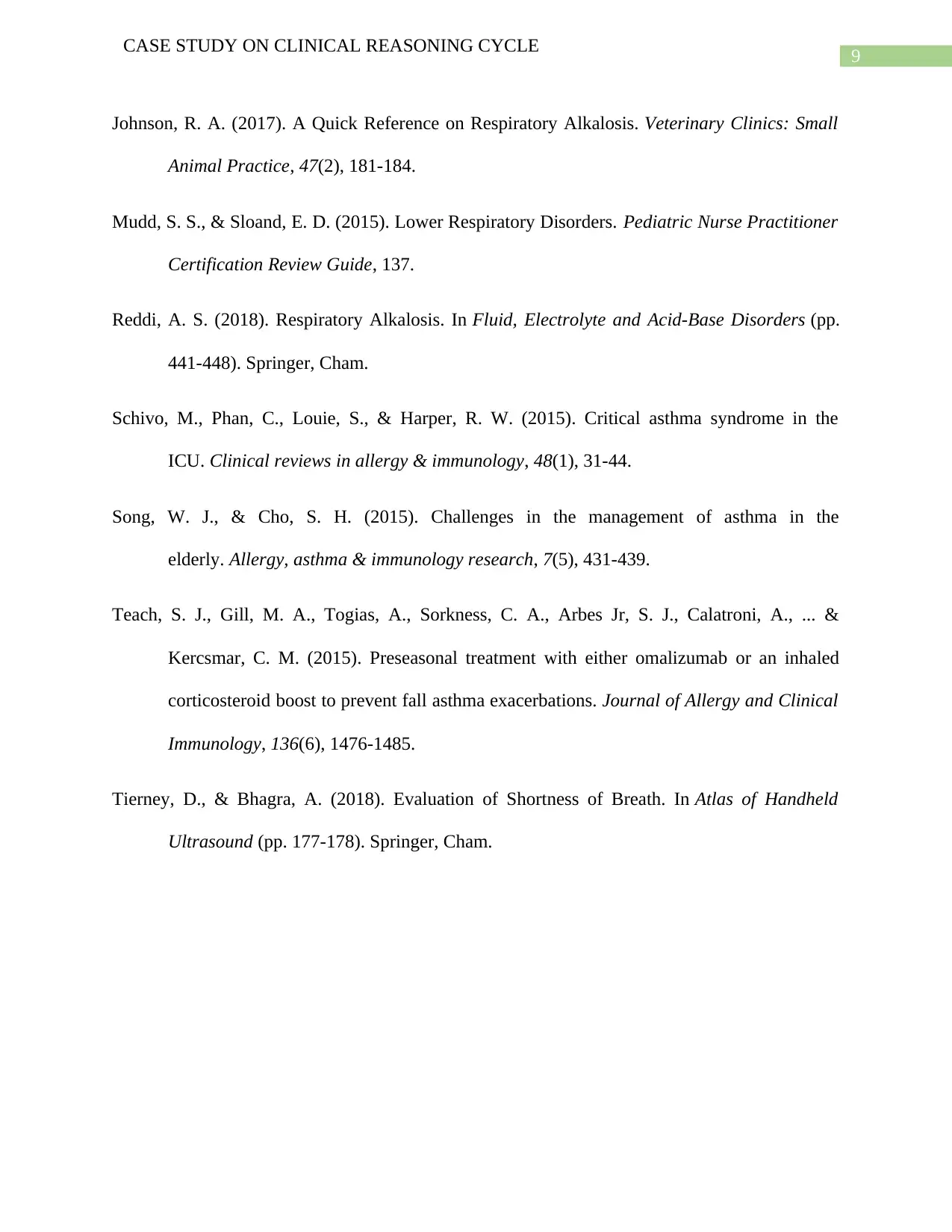
9
CASE STUDY ON CLINICAL REASONING CYCLE
Johnson, R. A. (2017). A Quick Reference on Respiratory Alkalosis. Veterinary Clinics: Small
Animal Practice, 47(2), 181-184.
Mudd, S. S., & Sloand, E. D. (2015). Lower Respiratory Disorders. Pediatric Nurse Practitioner
Certification Review Guide, 137.
Reddi, A. S. (2018). Respiratory Alkalosis. In Fluid, Electrolyte and Acid-Base Disorders (pp.
441-448). Springer, Cham.
Schivo, M., Phan, C., Louie, S., & Harper, R. W. (2015). Critical asthma syndrome in the
ICU. Clinical reviews in allergy & immunology, 48(1), 31-44.
Song, W. J., & Cho, S. H. (2015). Challenges in the management of asthma in the
elderly. Allergy, asthma & immunology research, 7(5), 431-439.
Teach, S. J., Gill, M. A., Togias, A., Sorkness, C. A., Arbes Jr, S. J., Calatroni, A., ... &
Kercsmar, C. M. (2015). Preseasonal treatment with either omalizumab or an inhaled
corticosteroid boost to prevent fall asthma exacerbations. Journal of Allergy and Clinical
Immunology, 136(6), 1476-1485.
Tierney, D., & Bhagra, A. (2018). Evaluation of Shortness of Breath. In Atlas of Handheld
Ultrasound (pp. 177-178). Springer, Cham.
CASE STUDY ON CLINICAL REASONING CYCLE
Johnson, R. A. (2017). A Quick Reference on Respiratory Alkalosis. Veterinary Clinics: Small
Animal Practice, 47(2), 181-184.
Mudd, S. S., & Sloand, E. D. (2015). Lower Respiratory Disorders. Pediatric Nurse Practitioner
Certification Review Guide, 137.
Reddi, A. S. (2018). Respiratory Alkalosis. In Fluid, Electrolyte and Acid-Base Disorders (pp.
441-448). Springer, Cham.
Schivo, M., Phan, C., Louie, S., & Harper, R. W. (2015). Critical asthma syndrome in the
ICU. Clinical reviews in allergy & immunology, 48(1), 31-44.
Song, W. J., & Cho, S. H. (2015). Challenges in the management of asthma in the
elderly. Allergy, asthma & immunology research, 7(5), 431-439.
Teach, S. J., Gill, M. A., Togias, A., Sorkness, C. A., Arbes Jr, S. J., Calatroni, A., ... &
Kercsmar, C. M. (2015). Preseasonal treatment with either omalizumab or an inhaled
corticosteroid boost to prevent fall asthma exacerbations. Journal of Allergy and Clinical
Immunology, 136(6), 1476-1485.
Tierney, D., & Bhagra, A. (2018). Evaluation of Shortness of Breath. In Atlas of Handheld
Ultrasound (pp. 177-178). Springer, Cham.
1 out of 10
Related Documents
Your All-in-One AI-Powered Toolkit for Academic Success.
+13062052269
info@desklib.com
Available 24*7 on WhatsApp / Email
![[object Object]](/_next/static/media/star-bottom.7253800d.svg)
Unlock your academic potential
Copyright © 2020–2025 A2Z Services. All Rights Reserved. Developed and managed by ZUCOL.




